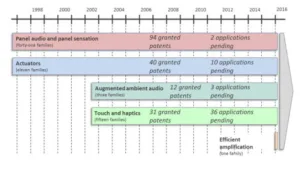We met with Redux, a company that is based in the UK, in Cambridge and is working on sound and haptics. It describes its technology as ‘bringing surfaces to life’. The company was set up to exploit the ip developed by HiWave (formerly NXT) which we first reported on in October 1996 (Display Monitor Vol 3 #40!) and that developed the concept of using a flat panel display surface (or other flat surface) as a speaker.
Redux has a long history in audio and haptics – from NXT.
The company is working on adding haptic feedback as well as sound. It can use a range of different actuators, including magnetic coils where space and power are less limited, such as automotive applications, or piezo beams or piezo patches where space is tight. Because of the work that the company has done on very tight control of the vibrations over flat surfaces, it is able to deliver different touch sensations to two different fingers, at the same time. That means a wide range of touches and gestures can get appropriate haptic feedback – a desirable feature for automotive or avionic applications. The technology has been used in very difficult vibration conditions, such as in a helicopter, and can show that the haptic feedback is still very clear.
The Redux technology can also use a display as a speaker and there was a good demonstration. In touch applications, having the sound coming from the display can be very useful in helping the user to select a particular function and the haptics can reinforce this. It can also mean that a device maker may be able to completely abandon the speaker – which makes it easier to make smaller smartphones and to waterproof or ruggedise them. With a larger display, Redux, such as an OLED TV, the larger space means that the firm can create stereo sources from a single display.
Analyst Comment
This technology, as I mentioned, has been around a long time, but it has become more refined. It is also helped, I think, by the kind of simple and very solid sheet that an OLED display is. The technology works on an LCD, but must be more challenging, given the relatively complex mechanical structure of LCDs.
Now, Sony had an OLED TV at the show, where the OLED panel itself acts as a speaker and LG Display had it in its meeting room. Redux did not claim that Sony is a client, but if I was a gambling man…. (BR)

